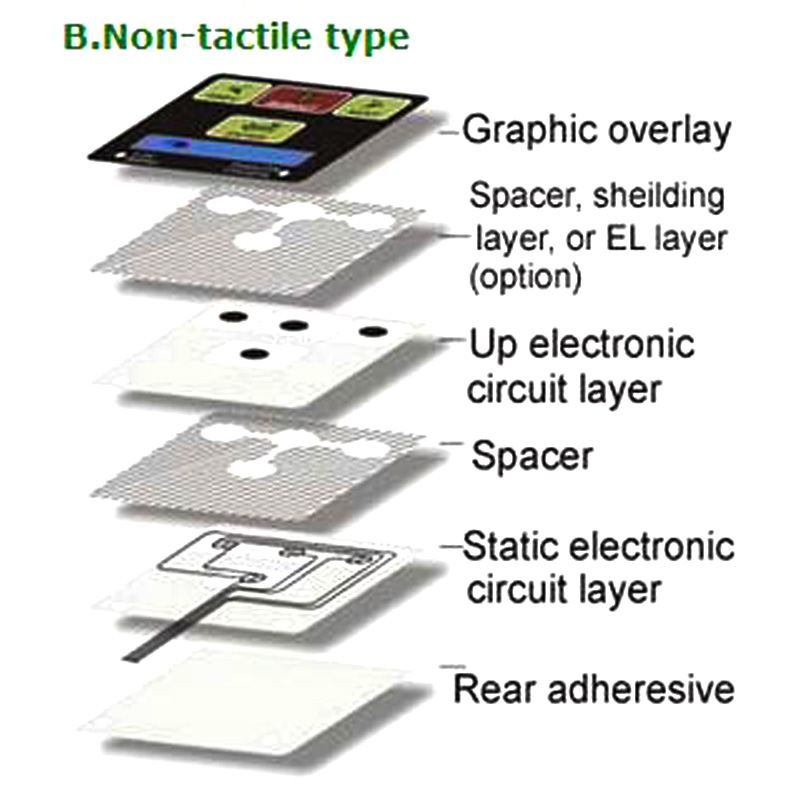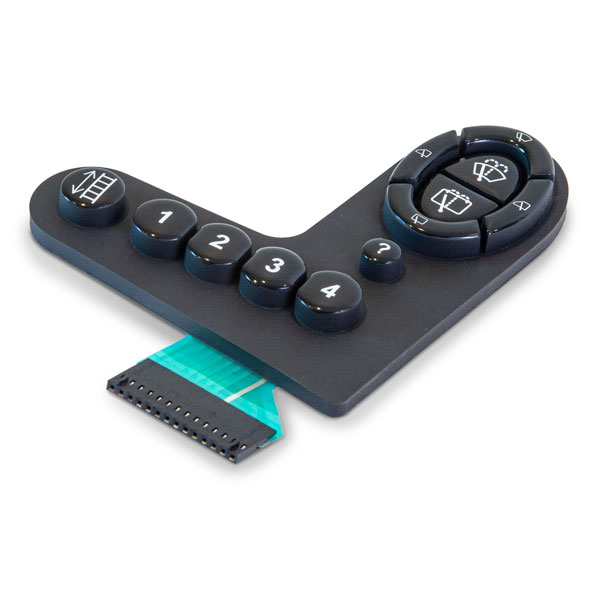The Production Process Behind Membrane Layer Change: What You Need to Know
The production process behind membrane layer switches combines mindful style, product choice, and quality control. It starts with understanding the details of membrane button design and proceeds with numerous stages, consisting of material selections and printing techniques. Each stage plays an important duty in guaranteeing capability and sturdiness. The complexities of layer building and construction and the rigorous testing requirements might disclose insights that are not instantly apparent. What lies past these fundamental components?
Understanding Membrane Switch Over Layout
Although membrane switches might show up simple initially glimpse, their layout entails intricate considerations that ensure capability and resilience. The design process begins with a comprehensive understanding of individual demands, consisting of the interface's designated application and environmental aspects. Functional designs is a crucial element, as the format needs to promote convenience of usage while making sure that responsive comments satisfies user expectations.Moreover, the layering of components, such as graphic overlays, glue layers, and conductive traces, have to be specifically crafted. membrane switch. This split setup not only influences the button's responsiveness yet likewise affects its longevity. Attention is offered to the securing methods employed to protect versus dampness and dust, which could endanger efficiency. Furthermore, design factors to consider expand to appearances, where color design and aesthetic quality improve user experience. Ultimately, the layout of membrane switches equilibriums performance, user experience, and longevity, making certain that they satisfy the needs of different applications efficiently
Products Utilized in Membrane Change Manufacturing
When picking materials for membrane layer switch production, it is vital to contemplate both efficiency and resilience. The key materials consist of polyester and polycarbonate films, which give versatility and toughness. These films are commonly covered with glue to ensure correct bonding to substrates. Conductive inks, commonly composed of silver or carbon, are essential for creating electric links within the button, allowing for trustworthy operation.Additionally, a protective layer, such as a hard layer, is regularly applied to improve scrape resistance and longevity. The option of backing product, such as acrylic or foam, can considerably affect the button's tactile feel and total user experience. Various environmental aspects, consisting of temperature level and moisture, should direct product choice to assure peak efficiency in particular applications. Inevitably, the appropriate mix of materials contributes to the membrane switch's performance and life expectancy, making notified options crucial for manufacturers.
The Printing Process: Creating Graphics and Text
The printing process in membrane switch manufacturing plays a significant role in producing top quality graphics and text. Various graphic design techniques are employed to guarantee visual appeal and capability, while mindful ink option approaches are crucial for durability and efficiency. Recognizing these components is basic for accomplishing finest results in membrane button layout.
Graphic Layout Techniques
Graphic style techniques play an important duty in the printing procedure of membrane buttons, as they specify how graphics and message will eventually appear on the last product. Reliable graphic design entails the tactical usage of layouts, shades, and fonts to enhance readability and aesthetic appeal. Developers frequently utilize vector graphics for scalability, guaranteeing that photos remain sharp at numerous sizes. Furthermore, focus to contrast and placement is important, as it affects customer communication and aesthetic top quality. The consolidation of branding components, such as logos, need to be handled with like keep brand stability. On the whole, thoughtful graphic style strategies contribute significantly to the capability and attractiveness of membrane buttons, influencing user experience and product efficiency.
Ink Option Methods
Choosing the ideal ink is important for accomplishing the wanted aesthetic quality and sturdiness in membrane layer button manufacturing. Various ink types are utilized, including solvent-based, water-based, and UV-curable inks. Each kind uses distinctive characteristics, such as adaptability, attachment, and resistance to environmental elements. Solvent-based inks are typically preferred for their toughness and vivid shades, while water-based inks are extra eco pleasant yet might have restrictions in bond. UV-curable inks supply fast treating and robust performance. Additionally, shade matching strategies assure that the chosen inks line up with style specifications. Ultimately, the choice of ink must take into consideration variables such as application approach, substrate compatibility, and end-use requirements to achieve superior outcomes in membrane layer switch graphics and text.
Layer Construction and Setting Up

Material Choice Refine
A mindful option of products is essential in the manufacturing process of membrane switches, as it directly influences performance and toughness. The key products made use of consist of polyester, polycarbonate, and numerous conductive inks. Polyester is usually preferred for its excellent resistance to chemicals and abrasion, making it suitable for harsh environments. Polycarbonate, on the various other hand, provides remarkable quality and influence resistance, which is valuable for applications calling for presence and effectiveness. Conductive inks, commonly made up of silver or carbon, are crucial for developing trusted electric pathways. Furthermore, the choice of adhesive products influences the general stability of the switch - membrane switch. Evaluating factors such as ecological direct exposure, tactile feedback, and visual needs guides manufacturers in picking the most effective products for their particular applications
Layer Adhesion Strategies
Sticking layers in membrane button building and construction is an important process that assures performance and longevity. Numerous bond techniques are used to protect perfect bonding in between layers, which normally include using adhesives, warm, and pressure. Pressure-sensitive adhesives (PSAs) are generally used for their ease of application and prompt bonding capabilities. In addition, thermal bonding methods can be used, where warm is made use of to trigger adhesive buildings, protecting a solid bond. The option of attachment technique greatly depends upon the products involved and the details application requirements of the membrane layer button. Appropriate placement and uniform application of adhesives are necessary to avoid flaws, securing the switch runs effectively throughout its designated life-span.
Quality Assurance Procedures
Guaranteeing quality assurance throughout the layer building and construction and assembly of membrane layer buttons is essential for preserving efficiency and integrity. This process usually entails several vital procedures, consisting of comprehensive assessments at each phase of manufacturing. Manufacturers use sophisticated screening approaches, such as peel examinations and adhesion assessments, to verify the stability of layer bonds. Furthermore, aesthetic examinations are performed to identify any defects in printing or material disparities. Environmental conditions, such as temperature and humidity, are thoroughly kept an eye on to ensure suitable Bonuses healing and attachment. In addition, normal calibration of tools assists preserve exact manufacturing requirements. By applying these top quality control procedures, makers can considerably decrease the risk of product failing, ensuring that the final membrane switches over fulfill the needed requirements and consumer expectations.
Evaluating and Quality Assurance Measures

Developments in Membrane Switch Over Innovation
As developments in modern technology remain to develop, membrane buttons are taking advantage of cutting-edge advancements that enhance their capability and individual experience. One noteworthy innovation is the combination of capacitive touch technology, which permits more receptive and user-friendly interface. This change not only boosts appearances however also minimizes mechanical wear and tear, expanding the lifespan of the switches.Additionally, innovations in graphic overlay products have caused improved toughness and resistance to environmental aspects such as dampness and UV light. These materials currently offer improved quality and brightness, additional boosting the visual appeal.Furthermore, the consolidation of clever innovation is changing membrane layer switches into interactive control board, enabling connectivity with IoT tools. This connection fosters a seamless customer experience, leading the way for applications in different sectors, from healthcare to consumer electronics. Jointly, these technologies position membrane changes as essential components in modern gadget style.
Regularly Asked Inquiries
For how long Does the Membrane Change Manufacturing Refine Take?
The period of the membrane layer button production procedure can differ substantially. click here to find out more Factors such as complexity, materials used, and production volume influence timelines, with common production ranging from a few days to a number of weeks for completion.
What Are the Typical Applications for Membrane Switches?
Membrane switches are typically utilized in various industries, consisting of automotive controls, household devices, clinical devices, and customer electronic devices (membrane switch). Their convenience and durability make them perfect for applications calling for user-friendly user interfaces and reliable performance in varied atmospheres
Can Membrane Switches Over Be Custom-made for Specific Needs?
What Is the Lifespan of a Common Membrane Layer Switch Over?
The lifespan of a typical membrane switch varies, however usually, it varies from 1 to 5 million cycles. Factors such as usage, environment, and material quality considerably affect longevity and total efficiency with time.

Are Membrane Switches Environmentally Pleasant?
The ecological kindness of membrane switches differs. Some products utilized may not be recyclable, while others can be environmentally friendly. The overall impact relies on making methods and materials, requiring cautious consideration throughout choice and disposal. The manufacturing procedure behind membrane layer changes combines careful layout, material selection, and top quality control. It starts with understanding the intricacies of membrane layer switch layout and advances through numerous stages, including product choices and printing strategies. When choosing materials for membrane layer switch production, it is vital to contemplate both efficiency and sturdiness. A careful choice of materials is necessary in the manufacturing procedure of membrane buttons, as it directly affects functionality and longevity. The option of attachment technique greatly depends on the materials entailed and the particular application needs of the membrane button.